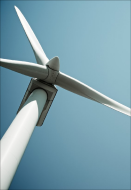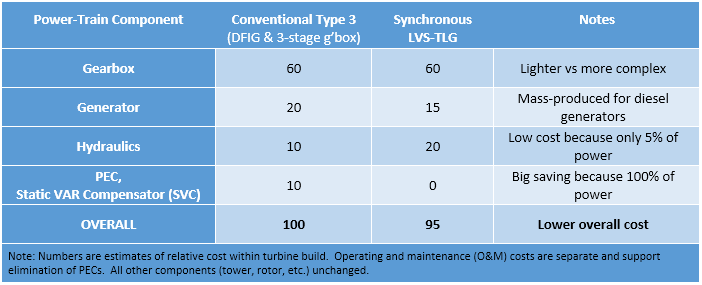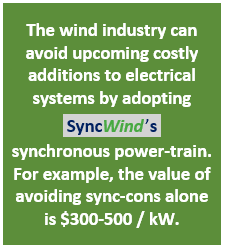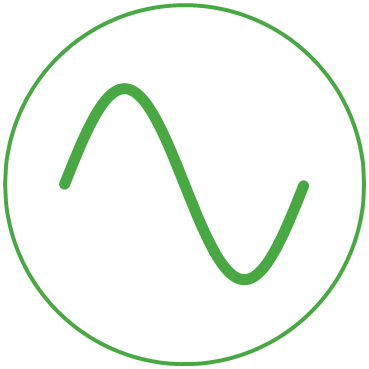|
|
|
|




○
Overview
●
Synchronous Power-train
○
Windflow™ 500




Executive Flyer

Power-train Brochure
 |
SyncWind
's
Synchronous
Power-train |
|
Our cost-effective, patented, proven system
enables turbine speed to vary
while the synchronous generator runs at constant speed:
No power electronics, type 5 grid connection at type 3 cost. |
|
|
|
SyncWind. will
work with wind farm owners, wind turbine manufacturers and/or power-train
suppliers who are at the forefront of wind energy and interested to utilise SyncWind.’s
proven power-train technology at multi-MW or mid-size scale.
Low Cost of Energy
SyncWind.’s synchronous power-train
is cost-effective, because it eliminates the need for power electronic
converters (PECs). PECs are rated at either 100% of the turbine rated power
(Type 4), or a large (30-40) percentage (Type 3). Either way they are a
significant capital cost. PECs are also known causes of maintenance costs,
seldom lasting 10 years in the field.
By contrast SyncWind.’s
proven power-train technology incorporates a small hydraulic sub-system,
which is rated at only 5% of turbine rated power. Remarkably the new,
patented “low variable-speed” (LVS) system enables broad-band variable speed
while keeping the hydraulics at only 5% of turbine rated power. Thus it can
address the global wind power market which is dominated by lower wind speed
sites than those found in New Zealand and Scotland. This is the key to its
cost-effectiveness. The following table illustrates how this will result in
lower turbine cost relative to the least-cost (Type 3) turbines available,
and lower wind farm cost.
No Power Electronics (PEC) = Lower Overall Power-Train
Cost = Lower Turbine Cost
|
|

|
|
No PECs, SVCs, Sync-cons*, DVARs* =
Lower wind farm
cost = Much lower COE *
|
-
Power-train costs are lower (per above table)
-
O&M costs are lower (no PECs)
-
No need for auxiliary services equipment for grid connection
(Sync-cons*, DVARs*, etc.)
Thus lower overall societal cost of renewable future
due to:
-
lower turbine cost (because of power-train capital +
O&M cost savings)
-
lower wind farm auxiliary costs
-
larger wind farm potential/less curtailment
* ... Sync-con
= synchronous condenser
* ... DVAR
= dynamic VAR controller
* ... COE = cost of energy
|
 |
|
 |
SyncWind.’s
power-train
enables its synchronous generator to be directly connected to the grid,
providing physical inertia for grid stability the same as traditional power
generators, without power electronics. For information on SyncWindi's
provided grid stability, please see our article "Grid
stability with renewables? Yes, Wind can! - SyncWindi’s power-train
and its synchronous generator provide physical inertia for grid stability".
Synchronous wind power is proven and cost-effective. Synchronous generators
enhance system security, reliability and resilience. Physical inertia and
large amounts of fault current are two attributes, in terms of which systems
with PECs cannot compete with synchronous generators. So wind power will
cost less and be better for grids – why wouldn’t the industry opt for
synchronous wind turbines?
|
|
 |
SyncWind.’s solution was awarded the
Efficient Solution Label by the
Solar Impulse Foundation, Switzerland,
of which SyncWind
is a
member.
In addition, please see the paper "Field
Experience with Synchronous Wind Turbines in New Zealand and Scotland" by
Geoff Henderson, presented at the “16th International Workshop on
Large-Scale Integration of Wind Power” 25 - 27 October 2017 in Berlin (http://windintegrationworkshop.org).
|
|
|
Grid connection types
Wind turbine grid connection types, such as the above
mentioned type 3 and type 5, are for example explained in
ELG4126 Wind Turbine Generators for Wind Power Plants
 ,
published by the School of Electrical Engineering and Computer Science (EECS) at
the University of Ottawa. ,
published by the School of Electrical Engineering and Computer Science (EECS) at
the University of Ottawa.
|
|